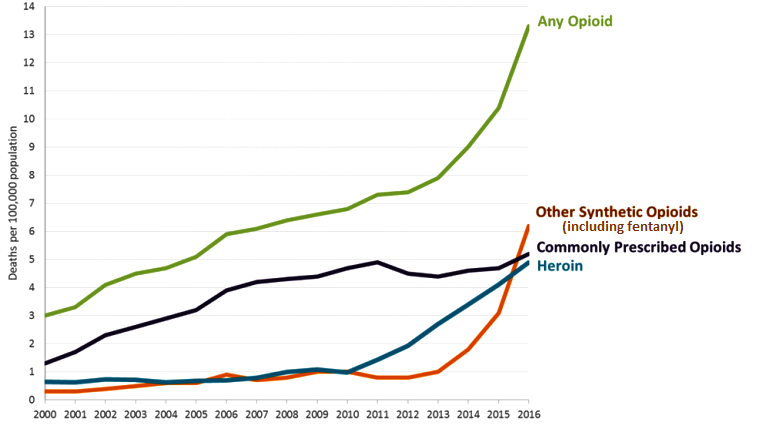Fentanyl is a synthetic opioid analgesic (pain reliever) that resembles morphine in its action. However, its drug potency is approximately 50 to 100 times more powerful than that of morphine, leading to high rates of both addiction and overdose deaths. In particular, the availability of fentanyl has increased dramatically since 2012, predominantly as the result of illegally manufactured and distributed quantities of the drug. According to the Centers for Disease Control and Prevention (CDC), fentanyl is the deadliest drug in the United States, surpassing heroin as the drug responsible for the greatest number of unintentional overdose deaths. Based on the CDC's latest analysis (covering the years 2011 through 2016 and reported in December 2018), the number of overdose deaths in 2016 as the result of fentanyl abuse was 18,335 (the number of heroin-related overdose deaths in 2016 was 15,961). This staggering number accounts for nearly one-third of all drug overdose deaths in the United States; in comparison, fentanyl accounted for only 4% of all overdose deaths in 2011. See also: Addiction and addictive disorders; Analgesic; Heroin: an addictive drug; Morphine alkaloids; Opiate; Pain

In general, the opioid crisis in the United States and elsewhere is the result of two main factors. The first factor is the overprescription of fentanyl. Although prescribed legally for the management of pain, fentanyl is often abused by patients, who fail to note the addictive power of the drug (which blocks pain receptors in the brain and increases the production of dopamine, leading to unsustainable euphoric states). As noted by the CDC, fentanyl has "immense potency and addictive potential," creating a dangerous situation for a person treating his or her pain with the drug. In many overdose victims, the overuse of fentanyl depresses the respiratory system to such an extent that it fails. The second factor involves the relative ease of manufacture of the drug and the proficient—although illicit—distribution of the drug through illegal drug channels. Most fentanyl-related deaths are caused by illegally produced versions of the drug, which also can be contaminated by harmful ingredients and laced with other drugs, including heroin or cocaine. (The converse is also true: for example, unsuspecting users of heroin often overdose from heroin that has been mixed with fentanyl.) See also: Brain; Dopamine; Incentive-sensitization disease model of addiction; Pharmaceutical chemistry; Pharmacology
The CDC is concerned about the significant and continuing uptick in fentanyl-related deaths. In addition, the number of overdose deaths is likely underreported. Because of varying methods of medical examinations and data collation, many overdose deaths are not attributed to a specific drug; instead, many deaths are simply categorized under the umbrella term of opioid overdose. Moreover, victims of fentanyl overdose often are abusers of other substances, including alcohol or narcotics (drugs that diminish the awareness of sensory impulses, especially pain, by the brain). Depending on the circumstances of death, these victims may have their deaths miscategorized. The CDC is responding to the fentanyl crisis by increasing awareness of the drug and its harmful effects. At the same time, law enforcement agencies are attempting to identify and limit the distribution of illegally made forms of the drug. See also: Alcohol; Alcoholism; Narcotic; Public health





